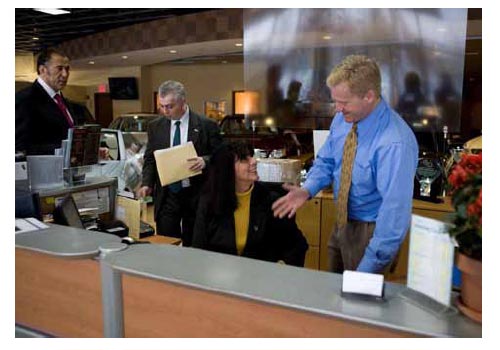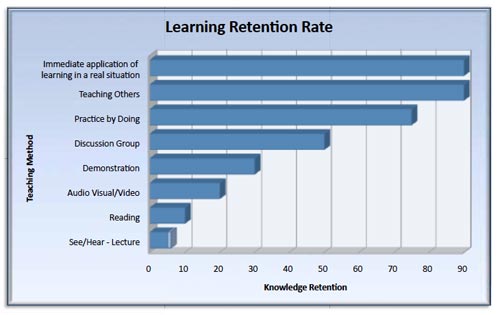Improve Your Training Effectiveness - Changing Employee Behavior
This article was originally published in the May/June 2011 issue of Fixed Ops Magazine and is being redistributed with permission of the Publisher.

Do you ever stop to think about how your employees’ behavior impacts customers’ satisfaction with your dealership? In most cases, their behavior, or the way they treat customers, probably has a huge impact on how your customers feel about doing business with you.
If their behavior has such an impact, what training are you providing for your employees in terms of how they should treat your customers? And does that training produce the desired employee behavior toward customers?
There are several options in terms of training. Most dealerships seem to take “the easy way out” and delegate training to one or more sources:
- Review of policies and procedures: employees are provided employee manuals, job descriptions, and process maps or work procedures.
- Other employees: when dealerships hire new employees, they are usually assigned to an existing employee to “shadow” them and figure out how things are done.
- Manufacturer’s formal training: employees participate in classroom and / or online training that covers interpersonal or job skills training that meet their requirements.
The bad news is that most training does not stick. Some researchers estimate that only about 25% of the skills taught to employees are in use just six months after the completion of training. And after one year, only 10% to 15% of the skills taught contribute some benefit to the organization.
The reasons that training fails to change employee behavior
Let’s look at some common reasons that employees do nothing different after being trained: 1) inefficient training methods are used; 2) employees do not practice the new skills learned; 3) employees return to work in the same environment; and 4) employees fall back on old habits because it’s easier.
Inefficient training methods are used
One of the big reasons training is ineffective is the percentage of retention of the information, which is impacted by the training method used. As you can see from the Learning Retention Chart, the highest retention percentage is a result of practicing by doing, teaching others and immediate application of learning in a real situation. Yet most classroom training provided uses the methods that result in the lowest or least amount of retention: lecture, visual / video, and group discussion. Because most training is delegated to other sources, managers do not feel like they can control the training methods, or the associated learning retention.
Employees do not practice the new skills learned
When employees return to their jobs after attending training, especially offsite training, they are usually faced with increased work load. In other words, they have to play “catch-up”. This leaves little time to even discuss the new skills learned during training, much less practice them. Often, they are not even asked by the manager or other employees anything about the training because they too have been overloaded during the absence of the employee who attended the training.
Employees return to work in the same environment
It’s difficult to be the only one trying something new in the same environment where everyone else is doing things the “same old way”. Unless all employees doing the same job are trained with the same skills, at the same time, new skills are often forgotten. For example, in one study showing the impact of salesperson training on sales performance, the training was found to be 67% more effective when accompanied by changes in environment, such as the training of their supervisor. Specifically, training for the managers so that they could coach and support the salespeople along with additional tools to support the just-learned skill sets.
“What training are you providing for your employees in terms of how they should treat your customers?”
Employees fall back on old habits because it’s easier
We all know how hard it is to change a habit. It’s easier to do things the same old way when no one is paying attention. When employees return from training, they have to determine on their own what behavior(s) they want to change. It’s difficult to stay motivated and create a new habit without a strong benefit for any behavior modifications. And it’s also easier to fall back on the old habit when there is no accountability. Since no one is keeping track of the new habit, why change?
How Can You Improve the Effectiveness of the Training at Your Dealership?
Let’s look at the facts in terms of training and employee performance. Training is an expense for all businesses. And it’s an ongoing challenge to ensure that employees provide an excellent customer experience. Is there a relationship between training and employees’ behavior? The answer is yes. But only if the skills taught are practiced immediately and are positively reinforced.

Here are five simple steps that other dealerships have implemented that have helped them to make training more effective AND to change the employees’ behavior:
- Ask the employee to present the training highlights.
Within two days of returning from a training event, the employee should recap the skills taught and report what, if any, ideas they want to implement. This can be done one-on-one with the manager or in a group setting with the manager and their peers. - Get buy-in from all of the employees.
Ask everyone for input as to how to make the new idea part of the process and daily routine. For example, a Service Advisor returns from a training course with a new word track to effectively present the dealerships’ inspection process during write-up. If you, as the manager, agree that it’s a good idea that should be implemented, then you would need to get buy-in from (and implement it with) all of the Service Advisors. - Assign the responsibility for training the other employees to the employee who attended the training.
Provide the tools and set the stage for success by ensuring that everyone understands both the importance of the new process and the benefits to implementing it. Observe the training and provide feedback as necessary. - Practice, practice, practice!
Once all the employees are trained, work with them one-on-one to let them demonstrate their new skills through role plays. Practice should be on-going to keep the new process “alive”. Also talk about it daily by conducting short meetings to discuss progress. - Become a better coach!
Hold the employees accountable by observing them in action and providing feedback. This alone will have a huge impact on the environment in your Service and Parts Departments by demonstrating that you, as the manager, are involved and care about the employees. Everyone appreciates recognition for their efforts!
“The highest retention percentage is a result of practicing by doing, teaching others and immediate application of learning in a real situation.”
Positive reinforcement is the key to keeping changes in place AND getting employees to actually change their behavior.
There are many challenges facing Fixed Operations Managers in today’s economic environment. Find the time to coach your associates toward changing their behavior toward customers. Try the five simple steps outlined here to improve your training effectiveness and actually change your employees’ behavior. The benefit to doing so is clear: change the way your employees treat your customers so that your customers feel good about doing business with you!
“We all know how hard it is to change a habit. It’s easier to do things the same old way when no one is paying attention.”
FixedOpsArticle.pdf